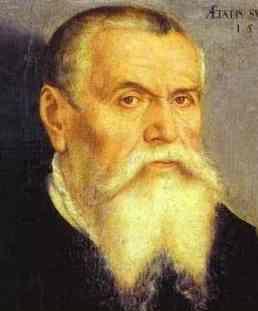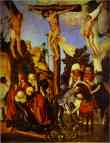Lucas Cranach the Elder Biography

Lucas Cranach (1472-1553) is a German painter, who named himself after his hometown of Kronach, near Bamberg. He seems to have spent his first years of training in his father's workshop. Nothing is known about his further training and his years of traveling. There is evidence that he worked in Coburg, Gotha, and Vienna, traveled in Danube valley, making drawings for woodcuts and also painting, around A.D. 1500-1504. Though no document attests it, the early meeting between Cranach and Dürer, whose workshop in Nuremberg enjoyed great fame, was unavoidable. Cranach had evidently studied Dürer’s graphic art intensively. In his paintings at that time, however, he tends towards “romanticism” The Crucifixion (1502), Rest on the Flight to Egypt (1504). Cranach is considered to be the initiator of the so-called Danube school.
In 1504 Cranach went as a court painter to Frederick the Wise of Saxony. In 1505 he settled permanently at Wittenberg. This concluded his first creative phase. There was a dramatic change in his style for which the court climate must, at least in part, be responsible. For half a century (1505-1553) Cranach’s life was closely connected with the life of the Saxon Electors. He accompanied Frederick the Wise on his travels to Nuremberg, and to Trient on the occasion of Maximilian I’s coronation. He carried out some delicate diplomatic missions and took part in all important events occurring at the court. He was very busy attending festivities, tournaments, burial and marriage ceremonies, he took part in hunting parties. He created numerous portrait of the members of the Electors family and members of the court, such as Portrait of Henry the Devout of Saxony (1514), Cardinal Albrecht of Brandenburg before the Crucified Christ (c.1520-1530), Portrait of the Saxon Elector John the Constant (1526), Portrait of Margarethe von Ponickau (1526), Portrait of Cardinal Albrecht of Brandenburg (1526), The Saxon Princesses (Sibyl, Emilia and Sidonia of Saxe) (c.1530). He also painted a lot of religious pictures: The Betrothal of St. Catherine of Alexandria (c.1516), Virgin and Child in a Grape Arbor (c.1525), Virgin and Child under an Apple Tree (c.1530).
In 1508 Cranach accompanied an embassy to the Emperor Maximilian I, and then to the Netherlands. A visit to the Netherlands in 1509 brought him into contact with Dutch art and indirectly with the conventions of the Italian Renaissance.
Cranach gained great esteem in Wittenberg. In 1537 and again in 1540 he was elected burgomaster of Wittenberg. He was closely associated with the German Reformers. Being a friend of Luther, he portrayed him several times. He became the great portraitist of the Reformation without, however, committing himself to any particular confession.
In the second quarter of the 16th century, while his workshop was flourishing, Cranach increasingly flavored a style tending towards the over-refined and mannerism. This is especially noticeable in his depiction of the female nude, such as Venus and Cupid (1509), Venus Standing in a Landscape (1529), Cupid Complaining to Venus (c.1530s), Venus with Cupid Stealing Honey (c.1531), The Judgment of Paris(1530), The Silver Age (The Effects of Jealousy) (1530). This too, may be induced by court life with its predilection for erotic representation.
In 1550, faithful to the elector John Frederick, who was accused of treason by Emperor Charles V, Cranach followed him in his exile at Augsburg, Innsbruck, and Weimar, where he died in 1553. Of three sons, all painters, the second, Lucas the Younger (1515-1586) painted so like his father that their works are difficult to distinguish.
Bibliography
Die Dresdner Galerie. Alte Meister. by M. Alpatow. VEB Verlag der Kunst. Dresden. 1966.
Cranach the Elder. by A. Nemilov. Moscow. 1973.
Malt, hände, malt. Ein Cranach-Roman. von Renate Krüger. Leipzig. 1975.
Cranach. by Viorica Guy Marica. Maridiane. Bucharest. 1983.
The Cranachs: A Family of Painters. by Werner Schade. Moscow. 1987. (in Russian)
Painting of Europe. XIII-XX centuries. Encyclopedic Dictionary. Moscow. Iskusstvo. 1999.
Lucas Cranach the Elder by Harald Marx. Konemann, 2002.
Lucas Cranach the Elder: 1472-1553 (Great Painters Series) by Alexander Stepanov. Parkstone Press, 1997.
Lucas Cranach: His Life, His World and His Art by Peter Moser. Babenberg, 2005.
- The Crucifixion.

1502. Oil on wood. Kunsthistorisches Museum, Vienna, Austria. Read Note.
- Rest On The Flight To Egypt.

1504. Oil tempera on wood. Staatliche Museen zu Berlin, Gemaldegalerie, Berlin, Germany. Read Note.
- Portrait Of Henry The Devout Of Saxony.

1514. Oil on wood. Alte Meister Gallerie, Dresden, Germany. Read Note.
- Cardinal Albrecht Of Brandenburg Before The Crucified Christ.

c.1520-1530. Oil on wood. Alte Pinakothek, Munich, Germany. Read Note.
- Portrait Of The Saxon Elector John The Constant.

1526. Oil on canvas. Alte Meister Gallerie, Dresden, Germany. Read Note.